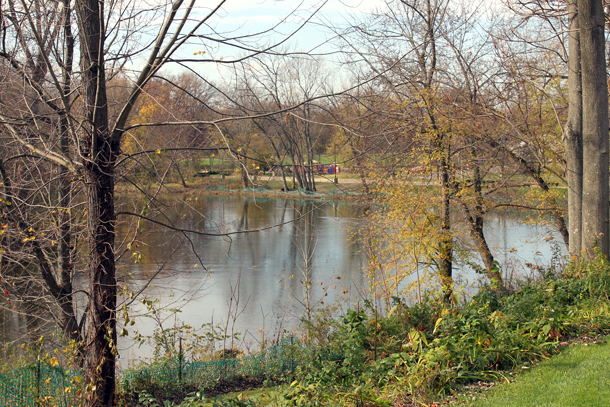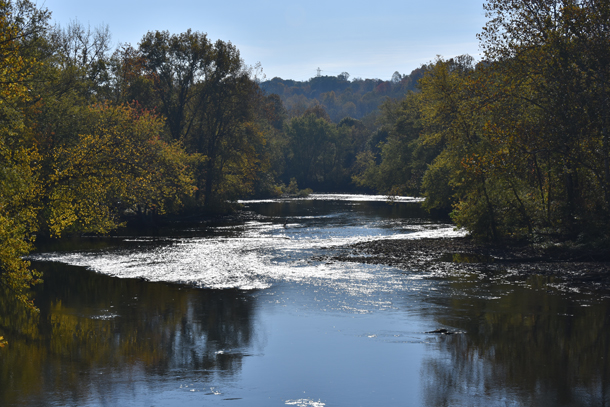Removing Dams in the Ohio River Watershed
Air Date: Week of March 13, 2020

The Summit Street Dam on the Mahoning River. (Photo: Jack Pearce, Flickr, CC BY-SA 2.0)
Hundreds of thousands of small dams dot the rivers of the United States, and now that many are no longer economically useful, some are being removed in an effort to protect fish and riverine ecosystems. Julie Grant of the Allegheny Front reports on a dam removal project in the Ohio River watershed.
Transcript
CURWOOD: It’s Living on Earth, I’m Steve Curwood.
Hundreds of thousands of small dams dot the rivers of the United States. They were once popular for use in grain mills and industry. And Many are no longer needed by people, but they continue to be a barrier to fish and wildlife. On the Mahoning River in Ohio the community of Lowellville is planning to remove a dam on their river but as Allegheny Front’s Julie Grant reports, not everyone is on board with the plan.
GRANT: Growing up in the small Riverfront village of Lowellville, Ohio by the Pennsylvania border, Jim Iudiciani, and he stayed away from the Mahoning river.
IUDICIANI: When I was a kid if I went near that river we get smacked because it was so dirty and dangerous.
GRANT: Now as mayor of Lowellville, he's been pushing for years to get rid of the old steel industry dam, that crosses the river here, and he says it's coming down this summer.
IUDICIANI: On the joking side, they call me the dam mayor and for good reason, finally.
GRANT: Just steps from the village downtown Iudiciani and he stands alongside the river where brush has been cleared for heavy equipment needed to remove the dam, a series of eight low concrete piers that point downstream. It will be the first in a regional plan to remove nine dams along the Mahoning River, which crosses into Pennsylvania and joins the Shenango to form the Beaver River. Right now people who canoe and kayak on the Mahoning need to pull their boats out of the water and carry them around the dam.
IUDICIANI: Where you see all the whiteness underneath. That's just the hydraulics, which makes it very dangerous.
GRANT: Ohio regulators describe these low head dams as drowning machines because canoes and other boats can get trapped in a recirculating current below the dam. Once the Lowellville dam is removed Ludiciani wants his riverfront village to become a hotspot for outdoor recreation. He points out where a new park with space for canoes is planned. He talks about a new restaurant.
IUDICIANI: bicycle shop, kayak rental.
GRANT: a yoga studio and new living space.
IUDICIANI: We're looking at four or five story buildings being built on the river possibly B and Bs and or condos with multi use parking underneath. Yeah, this whole thing is going to be a catalyst for us for development.
GRANT: It's a far cry from the region steelmaking days. But even after most steel mills closed and Ohio EPA survey still found the effects of pollution in the river.
DYER: They found fish with lesions and tumors on them. The macro invertebrate community was poor.
GRANT: That's Stephanie Dyer, environmental program manager for the East Gate Regional Council of governments, the agency leading the Mahoning dam removal project. In the late 1990s, the US Army Corps of Engineers looked into dredging the river to get rid of contaminants especially behind the low head dams. But the Corps never move forward with its river cleanup. Then in the early 2000s in Ohio grant program assisted with dam removals on the nearby Cuyahoga River.

The dams are being removed in the hopes of protecting wildlife, revitalizing the riverine ecosystem, and even promoting tourism. (Photo: Jack Pearce, Flickr, CC BY-SA 2.0)
DYER: And that's when it started to click here at East Gate as well as within the region that we can do this on our own as a local community as a region.
GRANT: According to East Gate, Lowellville and the cities of Struthers and Youngstown have secured more than $10 million to remove five dams with funding from the Ohio EPA and a settlement with LTV Corporation. That's about half of what's needed to remove all nine dams.
DYER: This river built the valley. And so now it's time we all realized which we're doing is giving back to the river and creating the free flowing state it should be in right now.
GRANT: But some communities don't want their dams taken down.
ANTHONY: You know what? We just want to be left alone.
GRANT: Edward Anthony is a trustee for Warren township a rural area 20 miles up river from Lowellville and home of the Leavittsburg dam. Local fire officials here say if their dam is removed, they won't have the pool of water it creates as a secondary source for emergencies. And health officials worry that without the damn water levels will be too low to dilute sewage from home septic systems.
ANTHONY:So it's a grave concern because I think if they proceed with this, they're going to do this and then we're going to be left with a mess.
GRANT: Looking down on the Mahoning at water flowing over the Leavittsburg dam resident Mike Arnold points across the river at what used to be in Ohio Edison facility.
ARNOLD: That's where the power plant set.
GRANT: The concrete dam was built to pool water for the plants but the electric company no longer uses it.
ST. CLAIR: Directly behind that dam is 12 feet.
GRANT: That's Russell St. Clair, who lives along the river which is almost like a lake behind the dam.
ST CLAIR: Just about maybe 400 yards up the river it goes to eight foot. Then it goes to seven foot like behind our house.
GRANT: St. Clair and his neighbor's float on pontoon boats and report seeing bald eagles and river otters. His kids and grandkids fish for muskie and perch.
ST CLAIR: The river now is better than it's ever been. I mean it is.
GRANT: Mike Arnold worries how the dam removal will affect fishing here.
ARNOLD: There's nothing for them to eat, the fish will be gone. They can't survive in that kind of water.

Lowellville in Northeast Ohio is home to the first dam being removed as a part of this project. (Photo: Stephanie Dyer)
GRANT: But in Ohio EPA study in 2006 found that fish communities behind the dam and Leavittsburg and elsewhere along the Mahoning were impaired. And according to East Gate, it's not yet known how the dam removal will change water levels. Ben Lorson wants to calm people's fears. After dams are removed, the same amount of water will still run down the river.
LORSON: And that's not going anywhere that'll always be there.
GRANT: Lorson is a fish passage biologist with the Pennsylvania Fish and Boat Commission. He says removing dams is better for fish.
LORSON: There's kind of this misconception that you know you're taking the good fishing spot away. When in reality those fish want to go upstream. They're just not able to because the dams in their way.
COLLIER: Oftentimes when it comes to aquatic organism passage we like to say if you unbilled it, they will come.
GRANT: Jessica Collier is a fish biologist with the US Fish and Wildlife Service. She says one fish in particular that could return to the Ohio by removing dams in the watershed is the lake sturgeon. These behemoth ancient fish can live up to 150 years. They migrate long distances, sometimes hundreds of miles to spawn. The sturgeon is considered endangered in most states throughout its range. They were over fished their habitat was destroyed and their migration paths were blocked by dams. Collier points to the success of a large dam removal project in the Sandusky river that flows into Lake Erie.
COLLIER: Within a couple months of dam removal there was a sturgeon that migrated up the river and it was the first time a sturgeon had been seen in that river system in maybe a century.
GRANT: And in the Ohio removing dams is bringing back people too according to federal fish biologist Donovan Henry, who coordinates the Ohio River Basin Fish Habitat Partnership.
HENRY: And pretty soon you have people kayaking and paddling and canoeing on these rivers has people using the river or making stops along the way to dine and shop so the community in the river start tying together and it does promote economic vitality.
GRANT: Standing on the banks of the Mahoning Lowellville Mayor, Jim Iudiciani And he wants that future for his village but looking at the river roll over the dam today, he still sees beauty in it.
IUDICIANI: Getting the surreal feeling sad feeling too that now it's coming out we're never going to see this again either, but it needs done. You know
CURWOOD: Reporter Julie Grant’s story comes to us courtesy of the Allegheny Front and is part of the series, Good River, produced by seven nonprofit newsrooms in the Ohio Valley. For a link to the series, go to our website, LOE.org.
Links
Living on Earth wants to hear from you!
Living on Earth
62 Calef Highway, Suite 212
Lee, NH 03861
Telephone: 617-287-4121
E-mail: comments@loe.org
Newsletter [Click here]
Donate to Living on Earth!
Living on Earth is an independent media program and relies entirely on contributions from listeners and institutions supporting public service. Please donate now to preserve an independent environmental voice.
NewsletterLiving on Earth offers a weekly delivery of the show's rundown to your mailbox. Sign up for our newsletter today!
 Sailors For The Sea: Be the change you want to sea.
Sailors For The Sea: Be the change you want to sea.
 The Grantham Foundation for the Protection of the Environment: Committed to protecting and improving the health of the global environment.
The Grantham Foundation for the Protection of the Environment: Committed to protecting and improving the health of the global environment.
 Contribute to Living on Earth and receive, as our gift to you, an archival print of one of Mark Seth Lender's extraordinary wildlife photographs. Follow the link to see Mark's current collection of photographs.
Contribute to Living on Earth and receive, as our gift to you, an archival print of one of Mark Seth Lender's extraordinary wildlife photographs. Follow the link to see Mark's current collection of photographs.
 Buy a signed copy of Mark Seth Lender's book Smeagull the Seagull & support Living on Earth
Buy a signed copy of Mark Seth Lender's book Smeagull the Seagull & support Living on Earth

